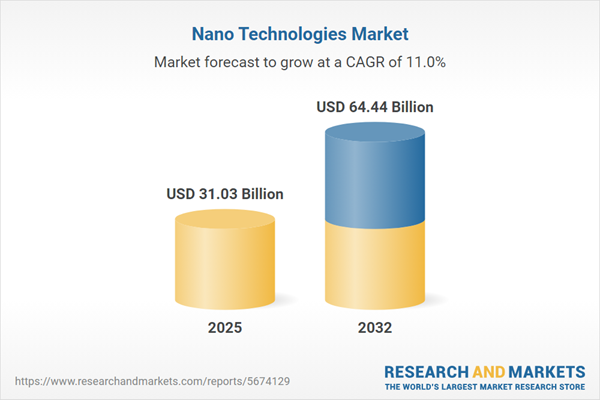Speak directly to the analyst to clarify any post sales queries you may have.
Nano technologies provide a critical platform for senior executives looking to drive operational efficiency, achieve regulatory adaptability, and accelerate high-value innovation. As industries transform, targeted insights help leaders implement agile strategies, navigate emerging regulations, and optimize technology-driven change across global markets.
Nano Technologies Market Snapshot: Size, Growth, and Dynamics
The global nano technologies market is currently valued at USD 27.95 billion in 2024 and is projected to reach USD 31.03 billion by 2025, with a compound annual growth rate (CAGR) of 11.00%. By 2032, forecasts indicate the market could expand to USD 64.44 billion.
This trajectory is fueled by robust demand for nanoscale solutions across manufacturing, healthcare, and energy. Industry leaders are prioritizing nano technology adoption to meet increasingly stringent regulations, minimize operational risk, and enhance business resilience. Integration of these technologies is widely recognized as essential for achieving sustained performance improvement and enabling enterprises to adopt adaptive, future-ready business models.Scope & Segmentation: Nano Technologies Market
This report offers detailed segmentation and actionable analysis, enabling executive leaders to manage strategic growth and mitigate risk in a complex environment. Each segment highlights significant adoption trends, technology applications, and commercial opportunities within the global nano technologies market.
- Product Types: Covers all consumable chemicals essential in nanoprocessing, as well as advanced testing equipment and manufacturing tools, which collectively facilitate pioneering research and agile transformation in diverse nanoengineering areas.
- Material Types: Explores carbon-based nanomaterials such as nanotubes and graphene; essential metals including copper, gold, and silver; a range of high-value metal oxides; and advanced polymers engineered for industrial applications.
- Technology Modalities: Features nanofilms with advanced coating properties, an array of nanoparticles like dendrimers and solid lipid types, as well as metal and silicon nanowires, and unique nanotube structures that drive cross-sector innovation.
- Processes: Assesses both top-down and bottom-up fabrication techniques that enable scalable, high-precision manufacturing for established and next-generation nano-enabled products.
- Application Areas: Analyzes uses in cosmetics, advanced electronics, batteries, environmental purification, diagnostics, therapies, wearable technologies, and smart textiles, each benefitting from advancements in nano technologies.
- End Users: Highlights integration across automotive, energy, electronics, and healthcare sectors, where nano-enabled solutions elevate product function and boost process efficiency.
- Geographical Coverage: Reviews adoption trends and regulatory frameworks in the Americas, EMEA, and Asia-Pacific, where different commercial strategies and market expansion initiatives shape competitive positioning.
- Company Coverage: Includes profiles and benchmarking of key players such as Evonik Industries AG, DuPont de Nemours, and Arkema SA, illustrating innovation pathways and sector leadership within nano technologies.
Nano Technologies Market: Key Takeaways
- Cross-disciplinary innovation accelerates product development, supporting successful integration of nano-enabled solutions in infrastructure, electronics, and healthcare markets.
- Collaboration between governments and private enterprises expedites the shift from research activity to marketable commercial applications, significantly reducing the innovation-to-market cycle.
- Enhanced local sourcing and expanded domestic manufacturing enable organizations to establish resilient supply chains and maintain regulatory readiness.
- Adopting sustainability-focused metrics allows companies to strengthen stakeholder confidence and adapt to evolving market imperatives.
- Regional disparities influence how adoption and scaling occur: the Americas and Asia-Pacific focus on rapid technology deployment, while EMEA emphasizes regulation and sustainable practices.
Impact of 2025 US Tariff Measures
Recent tariff policy changes in the United States on nano technology inputs are driving organizations to accelerate development of domestic capabilities and raise investment in local manufacturing operations. These policy shifts promote formation of new partnerships and targeted research programs, fostering the creation of more robust and adaptable supply chain models. A strengthened approach to resilience equips market participants to better predict and address risks emerging from regulatory and market disruptions.
Methodology & Data Sources
The findings in this report are based on executive interviews, specialist commentary, review of corporate disclosures, patent analysis, and industry association data. Each data point is independently verified and methodically modeled to ensure reliability and practical value for senior leadership decision-making.
Why This Report Matters
- Enables leadership teams to pinpoint priority nano technology segments and direct capital allocation to achieve strategic advantage.
- Facilitates adaptive supply chain management with comprehensive risk analysis for regulatory environments undergoing change.
- Delivers timely strategic frameworks to help executives navigate rapid technological and regulatory shifts impacting core markets.
Conclusion
Senior executives can leverage this report’s actionable intelligence to shape strategic priorities, seize new market opportunities, and manage transformation in the dynamic nano technologies landscape with confidence.
Additional Product Information:
- Purchase of this report includes 1 year online access with quarterly updates.
- This report can be updated on request. Please contact our Customer Experience team using the Ask a Question widget on our website.
Table of Contents
3. Executive Summary
4. Market Overview
7. Cumulative Impact of Artificial Intelligence 2025
Companies Mentioned
The companies profiled in this Nano Technologies market report include:- Evonik Industries AG
- DuPont de Nemours, Inc.
- Arkema SA
- Koninklijke DSM N.V.
- Cabot Corporation
- NanoXplore Inc.
- NanoDimension Ltd.
- Bruker Corporation
- Fujitsu Limited
- Thermo Fisher Scientific Inc.
Table Information
| Report Attribute | Details |
|---|---|
| No. of Pages | 187 |
| Published | November 2025 |
| Forecast Period | 2025 - 2032 |
| Estimated Market Value ( USD | $ 31.03 Billion |
| Forecasted Market Value ( USD | $ 64.44 Billion |
| Compound Annual Growth Rate | 11.0% |
| Regions Covered | Global |
| No. of Companies Mentioned | 11 |









